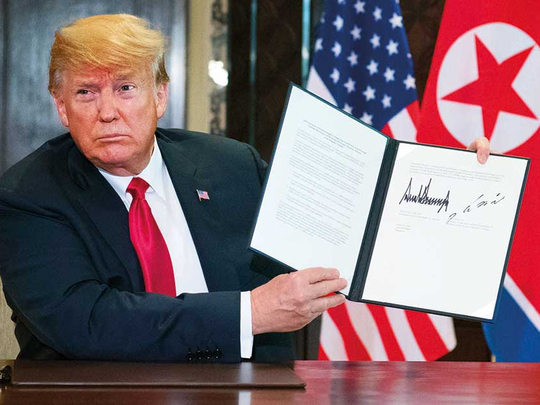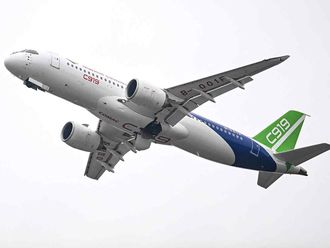
Singapore: Kim Jong-un’s distinctive signature, penned on a historic agreement with US President Donald Trump on Tuesday, indicates his ambition and creativity, handwriting experts said.
Trump’s signature, by contrast, indicates a more guarded personality, they said.
Graphologist Koo Bon-jin said Kim’s signature suggested an ambitious man who is “intuitive, rather than rational and logical”.
“He also writes very fast, which indicates he’s quick-witted and impatient,” Koo added.
Kim’s signature contrasts with Trump’s angular, closely packed autograph, said Karen Leong, a body language expert and director of Singapore-based consultants Influence Solutions.
“There is tremendous space between each character, which indicates a creative individual who is open to taking on new ideas, to evolving,” Leong said of Kim’s signature. “It indicates a confident person with big dreams and ambitions.” Trump’s signature, which Leong said looked like “arrows or skyscrapers”, points to people who “tend to wear a mask to hide their true nature”.
“While both signatures are very different, as both men really have different personalities, both in their own way want to make their mark,” she added.
Ahn Chan-il, a former North Korean military officer who heads the World Institute for North Korea Studies in Seoul, said Kim’s slanting signature was similar to those of his father and grandfather, both former leaders of North Korea.
“Not just the Kim family, but ordinary North Koreans would try hard to imitate the handwriting, believing it’s nice and divine,” added Ahn, who defected to South Korea in 1979.
In their first moments of meeting each other, US President Donald Trump and North Korean leader Kim Jong Un both sought to project a sense of command but displayed some anxiety at the start of their high-stakes summit in Singapore.
Body language experts said that in the 13 seconds or so the US president held on to the hand of Kim for the first time, he projected his usual dominance by reaching out first, and patting the North Korean leader’s shoulder.
Not to be outdone, Kim firmly pumped Trump’s hand, looking him straight in the eye for the duration, before breaking off to face the media.
“It wasn’t a straight-out handshake,” said Allan Pease, an Australian body language expert and author of several books on the topic, including “The Definitive Guide to Body Language”.
“It was up and down, there was an argy-bargy, each one was pulling the other closer. Each guy wasn’t letting the other get a dominant grip,” he told Reuters by telephone from Melbourne.
Trump and Kim are meeting in Singapore for historic talks aimed at finding a way to end a nuclear standoff on the Korean peninsula. Should they succeed, it could bring lasting change to the security landscape of Northeast Asia, like the visit of former US President Richard Nixon to China in 1972 led to the transformation of China.
Ahead of the meeting, Trump had said he would be able to work out within the first minute whether his North Korean counterpart was serious about making peace.
Projecting authority comes easily to Trump, who as a global leader, businessman and former television personality is well-versed in using body language effectively. He also has a height advantage over Kim.
While both men walked to the library where they held their first face-to-face meeting, Trump sought to ease any tension in the air by chatting to Kim, and letting him walk slightly ahead.
Trump, however, maintained control over the chat by patting Kim, and using his hand to guide him, who is almost half his age, into the room.
Kim also patted Trump, in an attempt to assert control. He mainly looked down, listening, as Trump spoke, but did look up at several times during the conversation.
“Donald Trump was talking in conciliatory terms, almost submissive, but his body language was clearly saying ‘I am in charge here’,” Pease said.
“If you didn’t know who these people were, you’d say the big guy was the father and the little guy is the son.”
Desire for dominance
Karen Leong, Managing Director of Singapore-headquartered Influence Solutions, said Trump did not display any of the hostility seen at the G7 summit in Canada last week, during which the US leader blasted allies including the European Union and Canadian Prime Minister Justin Trudeau over trade.
A photograph showing Trump sitting with his arms folded as German Chancellor Angela Merkel speaks was seen as defining the acrimonious nature of those talks.
Still, Trump’s desire for dominance was on display.
“Whenever they’re shaking hands, you can see the whites of their fingertips — these two guys are alpha males,” Leong said.
“They both want to show dominance and that is why there’s this bone-crushing handshake.” However, Leong said both found it difficult to conceal their nervousness once they were seated, with Trump displaying a slanted smile, and fidgeting with his hands and Kim leaning and staring at the ground.
“Trump is a gambler and he’s gambling on being able to rein in North Korea like a parent does to naughty child,” Leong said.
This contrasted with Kim, who had comparatively less to lose, having already scored a major win through Trump’s agreement to meet him.
Kim’s first major interaction with the international community also betrayed a sense of awe and wonder as he faced the rapid fire shutters of photographers in the opulence of the Singapore luxury hotel where the meeting took place.
“Kim looked a bit like a kid in a theme park: not intimidating, excited and a bit nervous,” Pease added.











